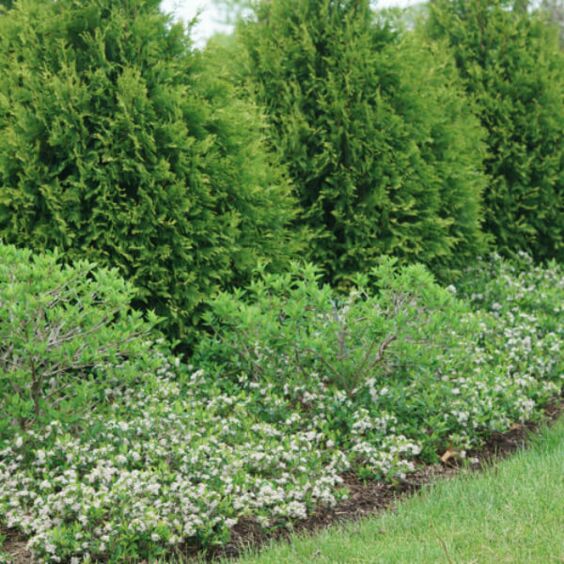
Growing zones
See Zone Map >Status: In stock
- Sun, Part Sun/Shade
Mature Plant Size (H x W): 1-1.5' x 2-3'
Bloom Season: Spring
- Attracts Bees
- Attracts Birds
- Drought Tolerant
- Salt Tolerant
- Native
- Winter Interest
- Rain Gardens
- Attractive Fruit
- Attracts Pollinators
Planting & Care for Chokeberry
Preparation
- Aronia plants do best in full sun, but will tolerate some light shade
- Partially shady locations will work, but they won't have as many berries.
- They aren't picky in regards to liking a certain soil type.
- Year-round interest with striking red fall color and berries in winter
- Wonderfully, dense and thick ground cover
- Great plant for slopes, parking beds, anywhere moving would be difficult or undesirable
Opening Plant Material
- Completely saturate all container plants by putting in a larger container of water until stops bubbling, then remove from the container.
Planting
- You can plant in early spring.
- In light soils that parch quickly, mulch in spring with moisture-conversing, bulky organics to keep roots cool and active.
- Dig a hole no deeper than the depth of the container and 6" or more wider on the sides.
- Slide plant from pot by tapping on the bottom of the pot.
- With shovel or knife trim bottom 2" off of the root ball for plants in plastic containers.
- Rotate the plant to the proper position. Never lift or move plants by the tops.
- Place the root ball in the hole.
- Adjust the plant height so the root crown is slightly higher than the ground.
- Place fertilizer packets into the bottom of the hole (if purchased). *Use Our Recommended Fertilizer
- Back-fill the hole with soil, making sure the top of the root ball is visible and slightly higher than the soil around it.
- Firm the soil around the plant. Water well to settle soil around the root ball.
- Water frequently when newly planted.
Pruning - After Planting
- Although it is not essential for container plants to be pruned after planting, a light pruning to remove any broken branches during shipment and improve shape will help the looks of your new planting.
Pruning - Through-out the Season
- Thanks to its dwarf habit, you'll rarely need to prune Ground Hog aronia. If you do need to trim it or cut it back, do so after blooming. However, this will remove the potential for fruit to form. Though it grows well in shaded conditions, best flowering and fall color will develop with some sun each day.
Watering - After Planting
Watering - Through-out the Season
- For the first couple years try to keep the moisture consistent. Water once or twice a week to provide an approximate inch of water a week to the plant. Once the plant is mature, it will require less water and will be more adaptable to whatever moisture Mother Nature provides.
- How do you know if your plants need water? The easiest way to tell is to touch the soil around the roots. If it is moist, there is no need to water. If it is dry, give it a good soaking with the hose end (no nozzle) watering the soil only, not the leaves.
Planting & Handling Help
Download our Planting and Handling Guide below to plan for a successful arrival and install of your plants. Be sure to water all plants as soon as they arrive and every day until you’re ready to plant. Keep any bare root bundles in a shady, cool spot with the roots covered at all times.


Learn More
Watch our videos on handling bare root plants, how your order is prepared for shipment and more.


Plant Sizing
What is the difference between Containers, Grow Bags, Bare Root, and Balled & Burlap (B&B)?
Shipping Times


Our FedEx and local shipping times depend on two factors, one is by the region and the second is the type of product being shipped. For example, small fruits are only shipped in spring, but majority of our perennials are shipped from spring until fall. Keep in mind the dates below act as a general guide. Due to unpredictable weather, staffing, inventory and industry demands these timelines can change. Therefore, we cannot guarantee any of these times.
Shipping Dates by Region*
Northern Cold Region: April 22nd - November 7th
Northern Region: April 15th - November 7th
Middle Region: April 1st - November 7th
Southern Region: March 15th - November 7th
Local Delivery (small radius from Waterloo, WI): April 22nd - November 7th
Shipping Dates by Season*
Spring Shipping: Region Start Date (above) - May
Fall Shipping: September - November
Due to unpredictable weather, these times may vary. Some varieties are exceptions due to heat and plant health reasons. Enter your shipping zip code at the top of this page and be sure to check the shipping information on each product before you add it to your cart. If the product is too large or restricted in your state, you will not be able to checkout with that item in your cart.
